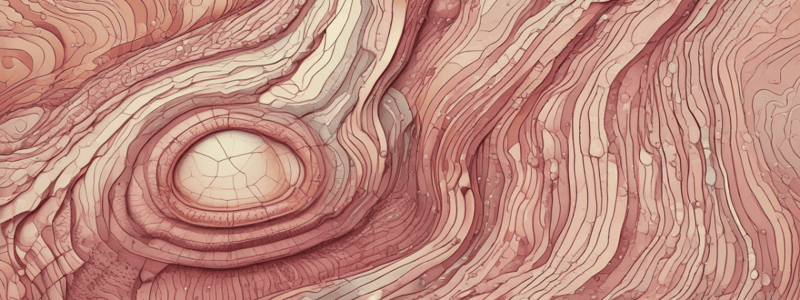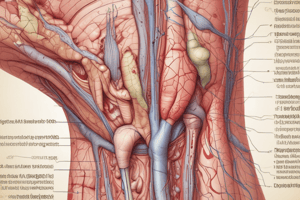Podcast
Questions and Answers
What is the main function of the sebaceous glands in the skin?
What is the main function of the sebaceous glands in the skin?
- To sense pain and temperature
- To produce sweat
- To synthesize vitamin D
- To produce sebum (correct)
What is the layer of skin that contains sensory nerve endings sensitive to pain, temperature, and touch?
What is the layer of skin that contains sensory nerve endings sensitive to pain, temperature, and touch?
- Subcutaneous tissue
- Superficial fascia
- Dermis
- Epidermis (correct)
What is the primary function of the dermis?
What is the primary function of the dermis?
- To provide structure and support (correct)
- To provide sensation
- To store fat
- To regulate body temperature
What is the main component of the superficial fascia?
What is the main component of the superficial fascia?
What is the function of the subcutaneous tissue?
What is the function of the subcutaneous tissue?
What is the function of the hair follicles in the skin?
What is the function of the hair follicles in the skin?
What is the main difference between the superficial fascia and the deep fascia?
What is the main difference between the superficial fascia and the deep fascia?
What is the location of the sweat glands in the skin?
What is the location of the sweat glands in the skin?
What is the primary function of skeletal muscles?
What is the primary function of skeletal muscles?
What is the main difference between synovial joints and fibrous joints?
What is the main difference between synovial joints and fibrous joints?
What type of muscle is found in the walls of internal hollow organs?
What type of muscle is found in the walls of internal hollow organs?
Which type of joint allows for the most freedom of movement?
Which type of joint allows for the most freedom of movement?
What is the process by which bones develop from hyaline cartilage models?
What is the process by which bones develop from hyaline cartilage models?
What type of joint has no movement?
What type of joint has no movement?
What is the primary function of epithelial tissue in the body?
What is the primary function of epithelial tissue in the body?
What is the type of muscle that forms the wall of the heart?
What is the type of muscle that forms the wall of the heart?
Which type of epithelial tissue is responsible for secreting products into ducts?
Which type of epithelial tissue is responsible for secreting products into ducts?
What is the term for the unions or junctions between two or more bones?
What is the term for the unions or junctions between two or more bones?
Which of the following systems is lined by epithelial tissue?
Which of the following systems is lined by epithelial tissue?
What is the origin of connective tissue in the body?
What is the origin of connective tissue in the body?
Which type of tissue is responsible for binding together and supporting other tissues in the body?
Which type of tissue is responsible for binding together and supporting other tissues in the body?
Which of the following organs is lined by epithelial tissue?
Which of the following organs is lined by epithelial tissue?
What is the characteristic of epithelial tissue that distinguishes it from other types of tissue?
What is the characteristic of epithelial tissue that distinguishes it from other types of tissue?
Which type of glandular epithelium secretes products into the bloodstream?
Which type of glandular epithelium secretes products into the bloodstream?
What is the primary function of the Lymphatic System?
What is the primary function of the Lymphatic System?
Which system regulates body functions via hormones secreted into the bloodstream?
Which system regulates body functions via hormones secreted into the bloodstream?
What is the primary function of the Respiratory System?
What is the primary function of the Respiratory System?
What is the primary function of the Digestive System?
What is the primary function of the Digestive System?
What is the primary function of the Urinary System?
What is the primary function of the Urinary System?
Which system consists of the kidneys, urinary bladder, ureters, and urethra?
Which system consists of the kidneys, urinary bladder, ureters, and urethra?
Which system has associated glands and organs in the digestive tract from mouth to anus?
Which system has associated glands and organs in the digestive tract from mouth to anus?
What is the main function of the Cardiovascular System?
What is the main function of the Cardiovascular System?
What is the main function of the skeletal muscle system?
What is the main function of the skeletal muscle system?
Which type of connective tissue is responsible for storing energy and insulating the body?
Which type of connective tissue is responsible for storing energy and insulating the body?
What is the primary function of the nervous tissue?
What is the primary function of the nervous tissue?
What type of cell is responsible for producing antibodies?
What type of cell is responsible for producing antibodies?
What is the main function of the integumentary system?
What is the main function of the integumentary system?
What type of connective tissue is found in the walls of hollow structures?
What type of connective tissue is found in the walls of hollow structures?
What is the function of macrophages?
What is the function of macrophages?
What is the main function of the skeletal system?
What is the main function of the skeletal system?
Flashcards are hidden until you start studying
Study Notes
Integumentary System
- The skin is the largest body organ, providing protection, heat regulation, sensation, and synthesis and storage of Vitamin D.
- Consists of two layers: epidermis (tough superficial layer with sensory nerve endings) and dermis (dense layer of collagen and elastic fibers).
- Contains specialized structures: hair follicles, musculi arector pili, sebaceous glands, and sweat glands.
- Subcutaneous tissue lies between the skin and deep fascia, containing sweat glands, superficial blood vessels, cutaneous nerves, lymphatics, and stored fat.
Connective Tissue Cells
- Fibroblasts: most abundant type, found in all connective tissues, and important contributors to ground substance and fibers.
- Macrophages: fixed or wandering, phagocytic cells.
- Plasma cells: mature B-lymphocytes producing antibodies.
- Mast cells: histamine-producing cells near blood vessels.
- Adipocytes: lipid storage cells.
Types of Connective Tissue
- Loose (Areolar) connective tissue: forms serous and synovial membranes.
- Adipose tissue: white and brown adipose tissue.
- Reticular connective tissue: found in lymphoid organs and adipose tissue.
- Dense connective tissue: fibrous and elastic tissue.
- Cartilage: hyaline, elastic, and fibrocartilage.
- Bone: skeletal tissue.
- Liquid connective tissue: blood and lymph.
Muscle Tissue
- Provides motion, maintenance of posture, and heat production.
- Three types:
- Skeletal: attached to bones, striated, voluntary.
- Cardiac: heart wall, striated, involuntary.
- Smooth: walls of hollow structures, not striated, involuntary.
Nervous Tissue
- Quickly communicates between parts of the body, sensitive to stimuli, interprets information, and coordinates action.
- Two types:
- Neurons: generate and conduct electrical impulses.
- Neuroglia: provide protection and support for neurons.
Organ Systems
- Integumentary System: skin, hair, nails, sweat glands, mammary glands, and enamel of teeth.
- Skeletal System: bones and cartilage, providing basic shape and support for body and muscle action.
Development
- Tissues develop from the separation of germinal layers in early development.
- Three layers: ectoderm, mesoderm, and endoderm.
- Epithelia develop from all three layers, while connective and muscle tissue develop from mesoderm, and nervous tissue develops from ectoderm.
Epithelial Tissue
- Forms the superficial layer of skin and some internal organs, inner lining of blood vessels, ducts, and body cavities.
- Characteristics: closely packed together, arranged in continuous sheets of one or more layers.
Connective Tissue
- Most widespread tissue in the body, binding together, supporting, and strengthening other tissues, protecting and insulating internal organs.
Articular System
- Consists of joints and ligaments, connecting bony parts of the skeleton and providing site of movement.
Muscular System
- Consists of skeletal, smooth, and cardiac muscle.
Nervous System
- Consists of central nervous system and peripheral nervous system.
- Sense organs: ophthalmic, olfactory, hearing and balance, and gustatory.
Circulatory System
- Consists of cardiovascular (heart and blood vessels) and lymphatic systems.
- Functions: conducts blood to the body and filters excess tissue fluid.
Respiratory System
- Consists of air passages and lungs.
- Function: supplies oxygen to blood and eliminates carbon dioxide.
Digestive/Alimentary System
- Consists of digestive tract, associated glands, and organs.
- Function: ingesting food and eliminating waste products.
Endocrine System
- System of ductless glands regulating body functions via hormones secreted into the bloodstream.
Urinary System
- Consists of kidneys, urinary bladder, ureters, and urethra.
- Function: filters blood and excretes urine (liquid waste).
Genital System
- Consists of gonads (ovaries, testes), ducts, and genitalia.
- Function: nourishes and delivers fetus.
Lymphatic System
- Filters excess tissue fluid, absorbs fats, and aids in immune responses.
Joints
- Unions or junctions between two or more bones.
- Classified into: plane, hinge, saddle, condyloid, pivot, and ball-and-socket joints.
Studying That Suits You
Use AI to generate personalized quizzes and flashcards to suit your learning preferences.




